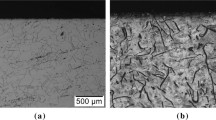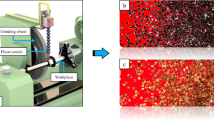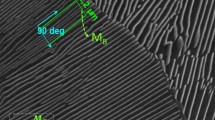Abstract
Grinding is one of the most common finishing processes used in the manufacture of metal components that require a combination of both smooth surface finish and tight tolerances. Despite the abundant knowledge concerning this process, specific literature is still scarce regarding the grinding of different cast iron grades. These materials have a wide application in the automotive industry, notably in the manufacture of gears, crankshafts, and valve control shafts. In this sense, this paper presents an experimental study of the peripheral surface grinding of three grades of cast iron grades (gray, nodular, and compacted graphite) with two SiC abrasive grinding wheels. The input variables tested were two values for depth of cut (15 and 30 μm) and two worktable speeds (5 and 10 m/min). The output variables analyzed were surface roughness, microhardness, microstructures, and SEM images of the ground surfaces. The results showed that gray cast iron provided the best performance concerning surface and sub-surface integrity among the three cast iron grades tested, whereas the nodular cast iron exhibited both worst finishing and superficial texture. No microstructural changes were observed in the samples of gray and compacted graphite cast iron grades, irrespective of the cutting conditions investigated, unlike for the nodular cast iron grade in which microstructural change was detected. The ranking order for the grindability of the three cast iron grades in terms of roughness, microhardness and surface texture investigated in this paper is gray cast iron, compacted graphite iron and nodular cast iron.
Similar content being viewed by others
References
Davis JR (1996) Cast iron. Specialty handbook
De Sousa JAG, Sales WF, Machado AR (2017) A review on the machining of cast irons. Int J Adv Manuf Technol 94:4073–4092. https://doi.org/10.1007/s00170-017-1140-1
Callister WD, Rethwisch DG (2013) Materials science and engineering, 9th edn. Wiley, New York
Marinescu ID, Hitchiner M, Uhlmann E, Rowe WB, Inasaki I (2007) Handbook of machining with grinding wheels. CRC Press, Nova Iorque
Mocellin F, Melleras E, Boehs L, Guesser WL (2004) Study of the machinability of compacted graphite iron for drilling process. J Braz Soc Mech Sci Eng 26:22–27. https://doi.org/10.1590/S1678-58782004000100004
Malkin S, Guo C (2008) Grinding technology: theory and applications of machining with abrasives, 2nd edn. Industrial Press, New York
Klocke F (2009) Manufacturing process 2: grinding, honing, lapping. Ed Springer
Moltrecht KH (1981) Machine shop practice, 2nd edn. Industrial Press, New York
Sosa AD, Echeverría MD, Moncada OJ, Sikora JA (2007) Residual stresses, distortion and surface roughness produced by grinding thin wall ductile iron plates. Int J Mach Tools Manuf 47:229–235. https://doi.org/10.1016/j.ijmachtools.2006.04.004
Xiao G, Stevenson R, Hanna IM, Hucker AS (2002) Modeling of residual stresses in grinding of nodular cast iron. ASME J Manuf Sci Eng 124:833
Fernandes LM, Lopes JC, Volpato RS, Diniz AE, De Oliveira RFM, De Aguiar PR, De Mello HJ, Bianchi EC (2018) Comparative analysis of two CBN grinding wheels performance in nodular cast iron plunge grinding. Int J Adv Manuf Technol. https://doi.org/10.1007/s00170-018-2133-4
Elliot R (1988) Cast iron technology. Butterworth & Co. Ltd
TUPY (2018) Continuous cast iron bars. Available at http://www.tupy.com.br/ingles/produtos/perfis_processo.php
Brooks R (2012) SinterCast logs new order for Tupy in Mexico. Foundry Management & Technology, United States of America. Available at: https://www.foundrymag.com/meltpour/sintercast-logs-new-order-tupy-mexico
Dawson S, Schroeder T (2004) Practical applications for compacted graphite iron. AFS Transactions, 04–047(05):1–9. Des Plaines, IL USA
Rowe WB (2014) Principles of modern grinding technology. 2nd ed. Elsevier Inc.
Marinescu ID, Rowe WB, Dimitrov B, Inasaki I (2004) Tribology of abrasive machining processes, 1st edn. William Andrew Inc, Norwich
Dawson S, Hollinger I, Robbins M, Daeth J, Reuter U, Schulz H (2001) The effect of metallurgical variables on the machinability of compacted graphite iron. Society of Automotive Engineers
Astakhov VP, Joksch S (2012) Metalworking fluids (MFWs) for cutting and grinding—fundamentals and recent advances. Woodhead, Cambridge
Pereira AA, Boehs L, Guesser WL (2006) The influence of sulfur on the machinability of grey cast iron FC25. J Mater Process Technol 179:165–171. https://doi.org/10.1016/j.jmatprotec.2006.03.100
Marwanga RO, Vogt RC, Cohen PH (2000) Influence of graphite morphology and matrix structure on chip formation during machining of continuously cast ductile irons. AFS Transactions, Des plaines
Fathallah BB, Fredj NB, Sidhom H, Braham C, Ichida Y (2009) Effects of abrasive type cooling mode and peripheral grinding wheel speed on the AISI D2 steel ground surface integrity. Int J Mach Tools Manuf 49:261–272. https://doi.org/10.1016/j.ijmachtools.2008.10.005
Acknowledgements
The Authors are grateful to Tupy, Saint Gobain Abrasives, and Blaser Swisslube Brazil, all Brazilian companies, for supporting this work with donation of workpiece material, grinding wheels and coolant, respectively.
Funding
The authors thank the CAPEX PROEX, FAPEMIG, and the Post Graduate Program of Mechanical Engineering of UFU for the financial support.
Author information
Authors and Affiliations
Corresponding author
Ethics declarations
Conflict of interest
The authors declare that there is no conflict of interest.
Rights and permissions
About this article
Cite this article
Da Silva, R.B., Lima, M.L.S., Pereira, M.F. et al. A surface and sub-surface quality evaluation of three cast iron grades after grinding under various cutting conditions. Int J Adv Manuf Technol 99, 1839–1852 (2018). https://doi.org/10.1007/s00170-018-2628-z
Received:
Accepted:
Published:
Issue Date:
DOI: https://doi.org/10.1007/s00170-018-2628-z




